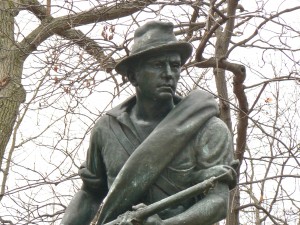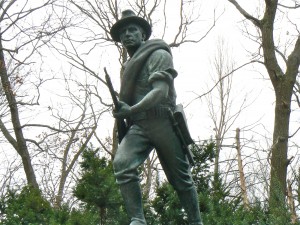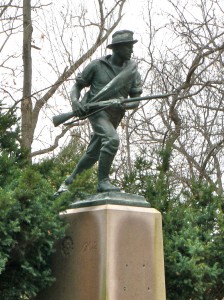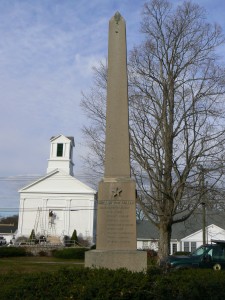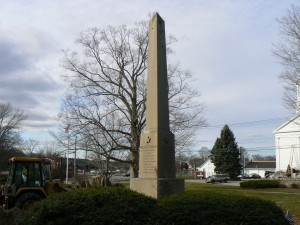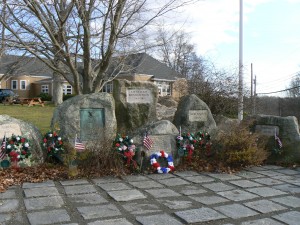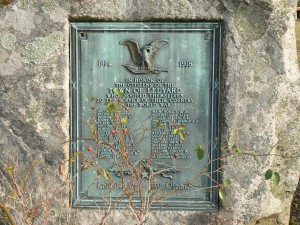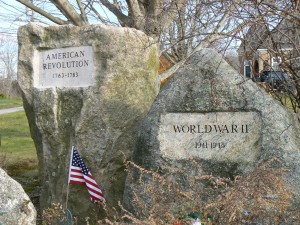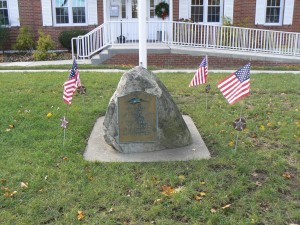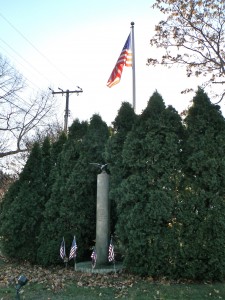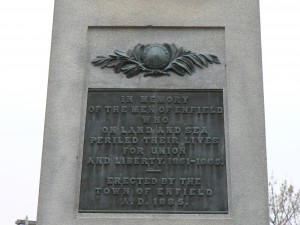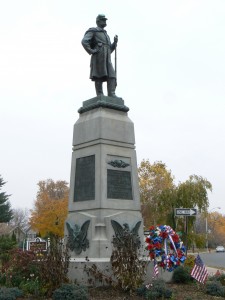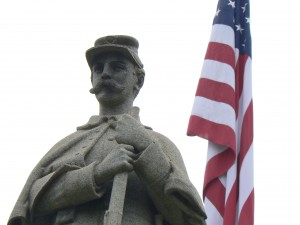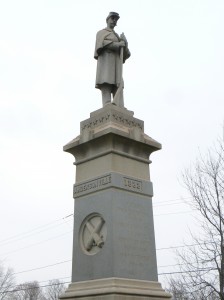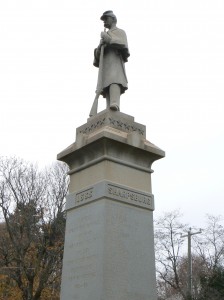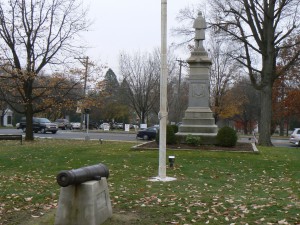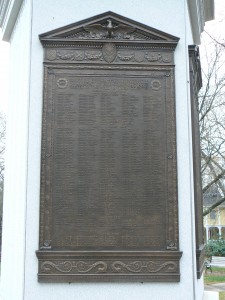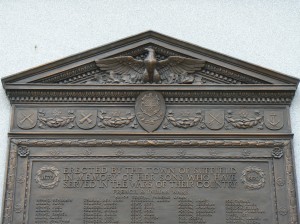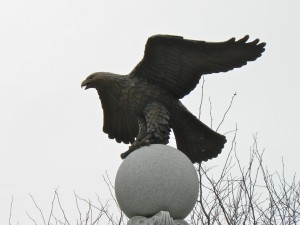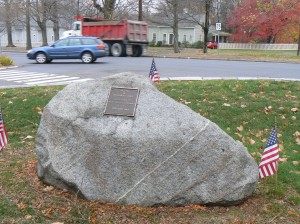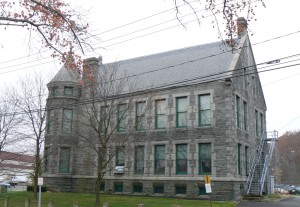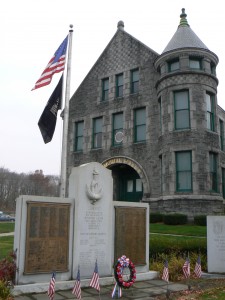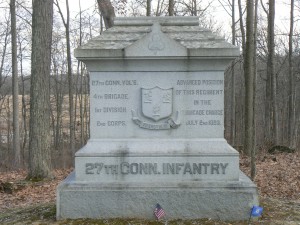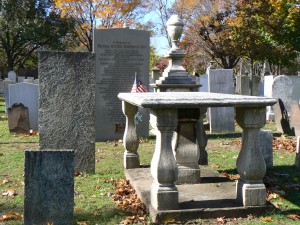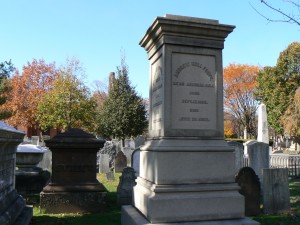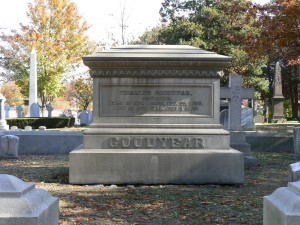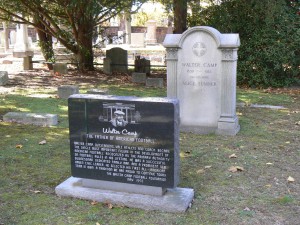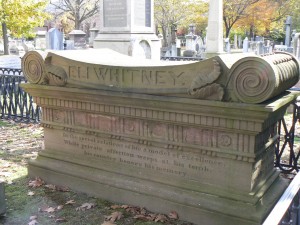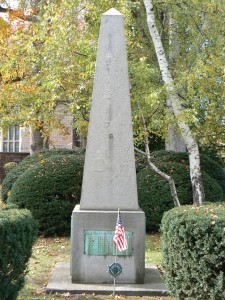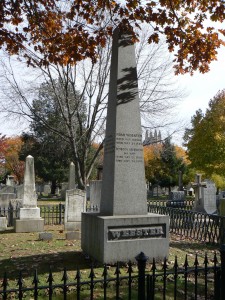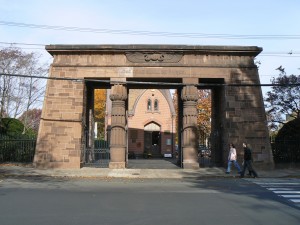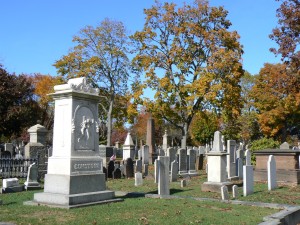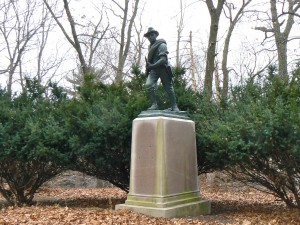 New Haven honors veterans of the Spanish-American and Philippine–American wars with a statue of a Marine.
New Haven honors veterans of the Spanish-American and Philippine–American wars with a statue of a Marine.
The Spanish-American War Monument in Edgewood Park was dedicated in 1926 to honor veterans of that war, the 1902 Philippine Insurrection and 1901-2 China Relief Expedition.
The monument depicts a Marine wearing a floppy hat and charging with a rifle. A dedication plaque on the front (northeast) side of the monument’s base was stolen in the 1970s.
The southeast side of the base bears the years 1898-1902 to honor the various conflicts the monument commemorates.
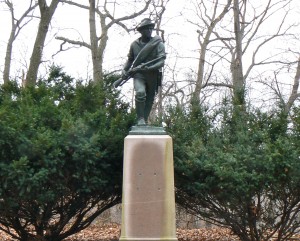 The statue was created by sculptor Michel Martino, whose other works include several statues in New Haven and a Spanish-American War memorial in New Britain.
The statue was created by sculptor Michel Martino, whose other works include several statues in New Haven and a Spanish-American War memorial in New Britain.
The monument was restored in 2008 as part of a New Haven initiative to clean and repair its public memorials.
The marine figure, like many memorials to the Spanish-American War, was cast from metal recovered from the USS Maine. Plaques cast from the Maine can be seen in Naugatuck, Meriden, Bridgeport and other Connecticut towns.
Source: Smithsonian American Art Museum, Art Inventories Catalog
Tags: New Haven
 Ledyard honors its Civil War heroes with a granite obelisk outside one of the town’s libraries.
Ledyard honors its Civil War heroes with a granite obelisk outside one of the town’s libraries.
The monument was erected in 1873 to honor Ledyard residents killed in the conflict. A dedication on the monument’s front (north) face reads, “In honor of the men of Ledyard who fought for the preservation of the Union in the war of 1861-5. Erected July 4, A.D. 1873, by Ledyard Bill.”
The north face also features a raised United States shield and two crossed swords.
The south, east and west faces bear the names of 29 Ledyard residents killed in the Civil War.
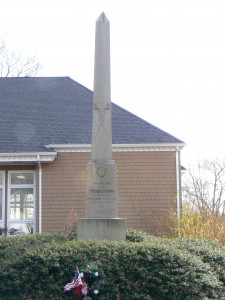 The monument was donated by Ledyard Bill, a Ledyard native who prospered in the publishing industry in Kentucky and New York. Bill later served as a legislator in Massachusetts.
The monument was donated by Ledyard Bill, a Ledyard native who prospered in the publishing industry in Kentucky and New York. Bill later served as a legislator in Massachusetts.
Bill’s family was long active in Ledyard, with a brother endowing the Bill Library next to the Civil War monument, and another brother funding the Bill Memorial Library in Groton.
A short walk away from the Civil War monument, a collection of monuments honors Ledyard’s veterans of other wars. A bronze plaque affixed to a boulder honors 32 residents who served in World War I and four who were killed.
Inscriptions on other boulders honor veterans of the American Revolution, World War II, Korea and Vietnam.
About a quarter-mile north of these monuments, an undated memorial in front of Town Hall honors all of Ledyard’s war veterans.
Tags: Ledyard
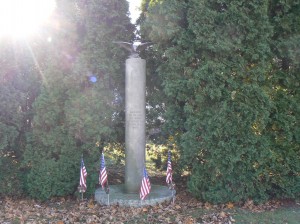 The Gales Ferry section of Ledyard honors war veterans with a small park and monument.
The Gales Ferry section of Ledyard honors war veterans with a small park and monument.
Memorial Parklet, at the intersection of Military Highway and Hurlbutt Road, was created in 1920. The park features a granite monument, dedicated in 1956, that features an eagle atop a 7-foot column.
A dedication on the monument’s shaft reads, “Dedicated to the men and women who served their country in all wars.”
The monument’s base is a former millstone.
The park is part of the Gales Ferry Historic District No. 2, which was added to the National Register of Historic Places in 2002.
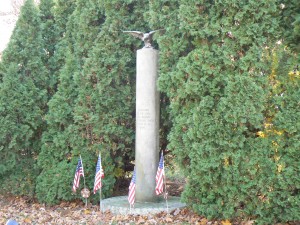 A wooden Honor Roll stood in the park between 1942 and 1956, when the granite monument was dedicated. A granite marker in front of the monument lists 16 names.
A wooden Honor Roll stood in the park between 1942 and 1956, when the granite monument was dedicated. A granite marker in front of the monument lists 16 names.
According to the district’s registration form, the monument’s granite shaft originally served as farm equipment. The shaft was one of several pulled by oxen and used to roll over freshly planted fields.
A nearly identical monument in Preston honors that town’s American Revolution veterans.
The Gales Ferry section of Ledyard is named for a ferry that operated across the Thames River starting in 1740.
Tags: Gales Ferry, Ledyard
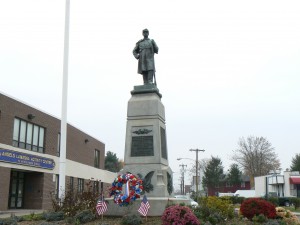 Enfield honors its Civil War and World War I veterans with a granite monument topped by a bronze infantryman.
Enfield honors its Civil War and World War I veterans with a granite monument topped by a bronze infantryman.
The Soldiers’ Monument, near the corner of Church and North Main streets, was dedicated in 1885 to honor Enfield’s Civil War heroes.
A dedication plaque on the monument’s front (south) face reads, “In memory of the men of Enfield who, on land and sea, periled their lives for Union and liberty, 1861-1865. Erected by the town of Enfield, A.D. 1885.”
A plaque on the east side of the monument lists 10 residents killed in action, 14 who died from wounds, and 15 who died while imprisoned in the Confederate POW camp at Andersonville, Georgia.
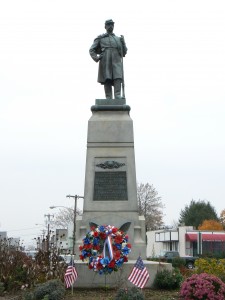 The monument’s west side features a plaque listing 29 Enfield residents who died (mostly likely from disease) during their Civil War service.
The monument’s west side features a plaque listing 29 Enfield residents who died (mostly likely from disease) during their Civil War service.
The monument’s base features four eagles with emblems representing the artillery, infantry, cavalry and navy.
The north face of the monument honors Enfield’s World War I heroes with a bronze plaque dedicated in 1922. The plaque reads, “In memory of those who gave their lives in the great war for world-wide liberty 1917-1919.”
The plaque lists eight residents killed in action and five (including a Red Cross nurse) who died in service.
The monument’s sculptor, David Richards, created a number of public works including monuments in Lawrence, Mass., and Manchester, N.H., as well as the newsboy statue in Great Barrington, Mass.
The infantryman was cast by the M.J. Power Foundry, which was also responsible for the Soldiers’ Monument in Derby.
Tags: Enfield
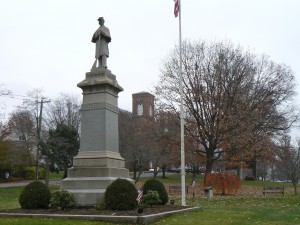 Suffield honors its Civil War veterans with an 1888 monument near the southern end of the Suffield green.
Suffield honors its Civil War veterans with an 1888 monument near the southern end of the Suffield green.
The Soldiers’ Monument bears a dedication on its front (south) face reading, “Suffield erects this memorial in honor of her citizen soldiers who died serving their country that the Union might be preserved. 1861-65.”
The monument features a granite infantryman holding a rifle at parade rest. In a nice touch, the soldier’s left foot extends beyond the monument’s base.
The monument’s east face lists the names and regimental affiliation of 31 Suffield residents lost in the Civil War. The east face also lists Sharpsburg, a town in Maryland where the 1862 Battle of Antietam was fought.
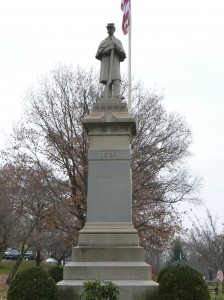 The north face bears an intricate state of Connecticut seal and honors Fort Wagner in South Carolina.
The north face bears an intricate state of Connecticut seal and honors Fort Wagner in South Carolina.
The west face displays crossed cannon representing the artillery and lists Andersonville, a town of Georgia where a large Confederate prisoner of war camp was built.
The monument was supplied by the Maslen Company of Hartford, and was most likely created by craftsmen in Barre, Vermont.
Tags: Suffield
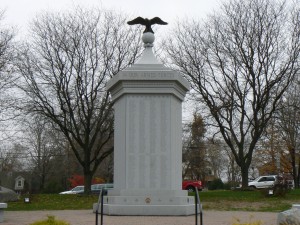 Suffield honors its veterans with a five-sided granite monument incorporating plaques from an earlier memorial.
Suffield honors its veterans with a five-sided granite monument incorporating plaques from an earlier memorial.
The 2003 monument in Veterans’ Park, near the intersection of Main Street (Route 75) and Bridge Street, honors Suffield veterans from wars ranging from the French and Indian Wars through the conflicts in the Persian Gulf.
The monument, topped by a large bronze eagle facing east, features a dedication reading, “In honor of the men and women of Suffield who served in our armed forces in the time of war.”
The monument also features two bronze Honor Roll plaques that appear to have been part of a 1920 memorial honoring veterans of earlier wars.
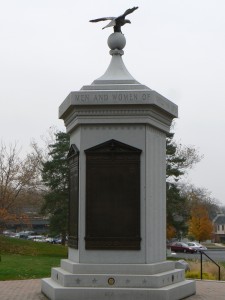 The plaques list veterans of the French and Indian War, American Revolution, War of 1918, Mexican War, Civil War Spanish-American War, and World War I.
The plaques list veterans of the French and Indian War, American Revolution, War of 1918, Mexican War, Civil War Spanish-American War, and World War I.
The granite sections honor veterans of World War II, Korean, Vietnam, and the Persian Gulf.
A plaque on a nearby boulder explains that Veterans’ Park was dedicated in 1983 to honor Suffield residents who served in Vietnam.
Tags: Suffield
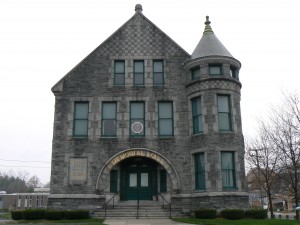 Windsor Locks honors its veterans with a granite building that hosts a collection of memorials and a museum.
Windsor Locks honors its veterans with a granite building that hosts a collection of memorials and a museum.
Memorial Hall was dedicated in 1891 as a home for the town’s Grand Army of the Republic post.
The building stands at the corner of Elm Street (Route 140) and Main Street (Route 159).
A dedication inscribed near the hall’s front entrance reads, “Soldiers’ Memorial Hall, built by Charles E. Chaffee and presented by him to J.H. Converse Post, No. 67, G.A.R., in memory of those who went from Windsor Locks and lost their lives in the service of our country in the late Civil War.”
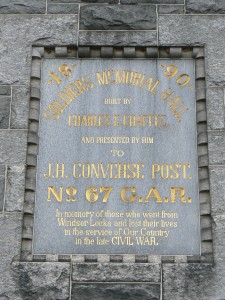 The inscription marks a fairly early use of the term “Civil War,” to describe the conflict, which is more commonly referred to as the “War of the Rebellion” on Connecticut monuments.
The inscription marks a fairly early use of the term “Civil War,” to describe the conflict, which is more commonly referred to as the “War of the Rebellion” on Connecticut monuments.
In front of the hall, a 1953 monument honors the service of Windsor Locks residents in the World Wars. The monument’s central section lists the seven residents lost in World War I and the 16 killed in World War II. The left and right sections include a Honor Roll listing the residents who served.
The 1953 monument is flanked by a pair of monuments, dedicated in 1976, honoring the service of Windsor Locks’ Korea and Vietnam veterans.
Memorial Hall, which today hosts the town’s American Legion post, also features two cannons in front of the building as well as a museum honoring the town’s war heroes.
Guided tours of the hall are conducted on the last Sunday of each month.
Charles E. Chaffee, who supplied most of the funding for Memorial Hall, was a textile manufacturer who also served as vice president of a bank and president of a bridge and ferry company, and held several municipal offices.
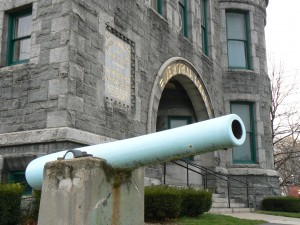 Joseph Converse, for whom the GAR post was named, was a Windsor Locks resident killed during fighting at Cold Harbor, Virginia, in 1864.
Joseph Converse, for whom the GAR post was named, was a Windsor Locks resident killed during fighting at Cold Harbor, Virginia, in 1864.
Like Madison, East Haven and Vernon, Windsor Locks decided to honor its Civil War veterans with a building instead of an outdoor monument. In most towns that built a hall, continued efforts by veterans resulted in a monument also being dedicated later.
Tags: Windsor Locks
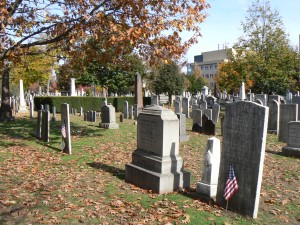 New Haven’s Grove Street Cemetery is one of the nation’s first suburban, park-like cemeteries.
New Haven’s Grove Street Cemetery is one of the nation’s first suburban, park-like cemeteries.
The cemetery marks the final resting place of many notable Connecticut residents.
Some historical figures buried there include statesman Roger Sherman, Civil War Admiral Andrew Hull Foote (who is also honored on Cheshire’s Soldiers’ Monument); David Humphreys (a Derby native and American Revolution general who served as an aide-de-camp to George Washington and an ambassador); Noah Webster; inventors Eli Whitney and Charles Goodyear; and a large number of New Haven settlers and Yale professors and leaders.
Free guided tours are offered on weekends between April and mid-November.
Cemetery History
The cemetery, still officially known as the New Haven City Burial Ground, was chartered in 1797 to provide an alternative to burials at the upper end of the New Haven Green.
Concerns about health and overcrowding at the existing burial ground (beneath and behind the location of Center Church) prompted James Hillhouse to purchase land from two farm that were, at the time, located outside the settled sections of downtown New Haven.
The cemetery was notable for its then-suburban location and its early use of family plots for internments.
By 1821, headstones from the original burial ground were transferred to Grove Street Cemetery and placed along the cemetery’s north and west walls in alphabetical order.
Over the years, the cemetery purchased adjoining land and ceded sections to the city to form its current configuration.
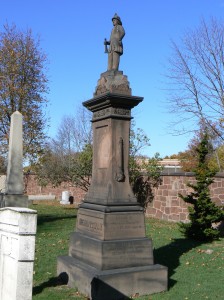
James T. Hemingway, chief engineer of the New Haven Fire Department, died fighting a Dwight Street store fire in 1952.
Tags: Hew Haven
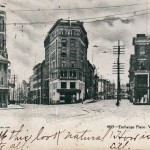 Along with monuments, we’ve long enjoyed collecting postcards and the glimpses they offer of Connecticut’s landmarks and history. Vintage postcards can show us how places, cars and fashions have changed over the years, as well as how many places have stayed the same.
Along with monuments, we’ve long enjoyed collecting postcards and the glimpses they offer of Connecticut’s landmarks and history. Vintage postcards can show us how places, cars and fashions have changed over the years, as well as how many places have stayed the same.
Rather than letting these images sit (more or less sorted) in boxes, we’ve decided to share them on our latest blog – CTPostcards.net. Every day, we’ll provide a different Connecticut postcard and highlight one small segment of the state.
Some landmarks you’ll recognize. Others have long been demolished. And some may seem like a curious inspiration for a postcard.
Either way, you hope you’ll find the site interesting.
Check back every morning, or you can subscribe to the site’s RSS feed.
